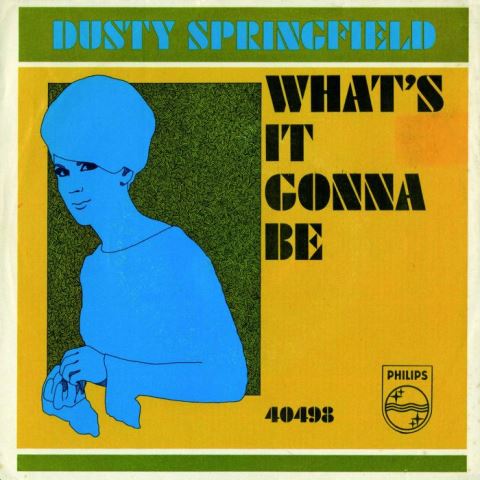Music Reissues Weekly: Dusty Springfield - Dusty Sings Soul | reviews, news & interviews
Music Reissues Weekly: Dusty Springfield - Dusty Sings Soul
Music Reissues Weekly: Dusty Springfield - Dusty Sings Soul
Twenty-four musical landmarks from the finest British soul singer of her era

First on were The Supremes with “Baby Love.” Next, The Miracles performed “You Really Got a Hold on me.” After this, Stevie Wonder’s “I Call it Pretty Music But the Old People Call it the Blues,” The Temptations’ “The Way You do the Things You do” and Martha & The Vandellas’ “Heatwave.”
The opening section of the Ready Steady Go! episode broadcast on 28 April 1965 was hot – really hot. The show was titled The Sound of Motown and its guest host was Dusty Springfield. She sang a song solo, and one with Martha Reeves.
 Those involved with the show knew Springfield was a high-profile ambassador for soul and that her records unambiguously telegraphed this. She had recorded in New York in September 1964 and was creating her own take on the music inspiring her. The folk-pop of The Springfields, who she left in October 1963, was long gone. Dusty Springfield was the right person for an all-Motown Ready Steady Go!
Those involved with the show knew Springfield was a high-profile ambassador for soul and that her records unambiguously telegraphed this. She had recorded in New York in September 1964 and was creating her own take on the music inspiring her. The folk-pop of The Springfields, who she left in October 1963, was long gone. Dusty Springfield was the right person for an all-Motown Ready Steady Go!
Dusty Sings Soul shows why. A neat 24-track collection of her soul recordings, it begins with “Can I Get a Witness” (1964) and ends with the mind-bogglingly brilliant non-hit “What’s it Gonna be” (1967). Tracks are from albums, EPs and singles, and the date range covered is 1964 to 1969. It dovetails with but sidesteps the 1969 Dusty In Memphis album (nothing is selected from it) and pre-dates 1970’s Gamble & Huff-produced A Brand New Me. What’s here are stepping stones leading to these albums.
While everything heard is great and stresses Springfield’s importance as a singer and visionary, aspects of the context further stress her status. Soul music was popular with audiences and bands in the first half of the Sixties. November 1963’s With The Beatles included versions of three Tamla/Motown songs. The Rolling Stones recorded “Can I Get a Witness” for their April 1964 debut album. Band’s live repertoires would mirror what audiences danced to in clubs. But Dusty Springfield went further - for her, soul was a raison d'être and driver for self-actualisation. It was more than just an aspect of her repertoire. She wanted to be at one with the music she loved. She succeeded.
 Up to 1968, though there were sessions in the US, what she recorded was mostly taped in London. Working in what wasn’t a natural home for soul meant there was a need to find a way to make the music and get the sound without coming across as a weak facsimile. The songs and her voice were no problem. The material she chose was often sourced from music publishers, records which had not yet been issued or singles she found in specialist record shops – so she wasn’t strictly recording cover versions. Still, what was issued had to convince. Otherwise there was no point in doing it.
Up to 1968, though there were sessions in the US, what she recorded was mostly taped in London. Working in what wasn’t a natural home for soul meant there was a need to find a way to make the music and get the sound without coming across as a weak facsimile. The songs and her voice were no problem. The material she chose was often sourced from music publishers, records which had not yet been issued or singles she found in specialist record shops – so she wasn’t strictly recording cover versions. Still, what was issued had to convince. Otherwise there was no point in doing it.
Thirteen of the 24 tracks were made with arranger Ivor Raymonde, who had also worked with The Springfields. From scratch, he was integral to creating the British soul sound. However, a move to Decca Records in 1966 meant he could no longer work with Springfield as she was on competitor label Philips. The arrangers who subsequently came on board worked from a basis which he and Springfield had formulated. When the pre-Led Zeppelin John Paul Jones was arranging for her, he knew what she and Raymonde had created. Her post-Raymonde UK recordings, to varying degrees, exist in the shadow of or develop what came earlier.
If she had lacked so sympathetic a studio arranger, what would happened with Dusty Springfield? The question is moot as what happened is what happened. Even so, it’s pertinent. The terrific Dusty Sings Soul is as much about how she achieved what she achieved as it is about the results. Dusty Springfield didn’t become the finest British soul singer of her era without knowing exactly what she was doing. That’s why she could stand shoulder-to-shoulder with Martha Reeves.
- Next week: Kokomo - To Be Cool. Previously unheard early recordings from the Brit soul-funk legends
- More reissue reviews on theartsdesk
- Kieron Tyler’s website
Explore topics
Share this article
The future of Arts Journalism
You can stop theartsdesk.com closing!
We urgently need financing to survive. Our fundraising drive has thus far raised £49,000 but we need to reach £100,000 or we will be forced to close. Please contribute here: https://gofund.me/c3f6033d
And if you can forward this information to anyone who might assist, we’d be grateful.

Subscribe to theartsdesk.com
Thank you for continuing to read our work on theartsdesk.com. For unlimited access to every article in its entirety, including our archive of more than 15,000 pieces, we're asking for £5 per month or £40 per year. We feel it's a very good deal, and hope you do too.
To take a subscription now simply click here.
And if you're looking for that extra gift for a friend or family member, why not treat them to a theartsdesk.com gift subscription?
more New music
 Music Reissues Weekly: Joe Meek - A Curious Mind
How the maverick Sixties producer’s preoccupations influenced his creations
Music Reissues Weekly: Joe Meek - A Curious Mind
How the maverick Sixties producer’s preoccupations influenced his creations
 Pop Will Eat Itself, O2 Institute, Birmingham review - Poppies are back on patrol
PWEI hit home turf and blow the place up
Pop Will Eat Itself, O2 Institute, Birmingham review - Poppies are back on patrol
PWEI hit home turf and blow the place up
 'Fevereaten' sees gothic punk-metallers Witch Fever revel in atmospheric paganist raging
Second album from heavy-riffing quartet expands sonically on their debut
'Fevereaten' sees gothic punk-metallers Witch Fever revel in atmospheric paganist raging
Second album from heavy-riffing quartet expands sonically on their debut
 theartsdesk Q&A: Soft Cell
Upon the untimely passing of Dave Ball we revisit our September 2018 Soft Cell interview
theartsdesk Q&A: Soft Cell
Upon the untimely passing of Dave Ball we revisit our September 2018 Soft Cell interview
 Demi Lovato's ninth album, 'It's Not That Deep', goes for a frolic on the dancefloor
US pop icon's latest is full of unpretentious pop-club bangers
Demi Lovato's ninth album, 'It's Not That Deep', goes for a frolic on the dancefloor
US pop icon's latest is full of unpretentious pop-club bangers
 Yazmin Lacey confirms her place in a vital soul movement with 'Teal Dreams'
Intimacy and rich poetry on UK soul star's second LP
Yazmin Lacey confirms her place in a vital soul movement with 'Teal Dreams'
Intimacy and rich poetry on UK soul star's second LP
 Solar Eyes, Hare & Hounds, Birmingham review - local lads lay down some new tunes for a home crowd
Psychedelic indie dance music marinated in swirling dry ice
Solar Eyes, Hare & Hounds, Birmingham review - local lads lay down some new tunes for a home crowd
Psychedelic indie dance music marinated in swirling dry ice
 The Lemonheads' 'Love Chant' is a fine return to form
Evan Dando finally gets back in the saddle with an album of new tunes
The Lemonheads' 'Love Chant' is a fine return to form
Evan Dando finally gets back in the saddle with an album of new tunes
 Music Reissues Weekly: Evie Sands - I Can’t Let Go
Diligent, treasure-packed tribute to one of Sixties’ America’s great vocal stylists
Music Reissues Weekly: Evie Sands - I Can’t Let Go
Diligent, treasure-packed tribute to one of Sixties’ America’s great vocal stylists
 'Deadbeat': Tame Impala's downbeat rave-inspired latest
Fifth album from Australian project grooves but falls flat
'Deadbeat': Tame Impala's downbeat rave-inspired latest
Fifth album from Australian project grooves but falls flat
 Heartbreak and soaring beauty on Chrissie Hynde & Pals' Duets Special
The great Pretender at her most romantic and on the form of her life
Heartbreak and soaring beauty on Chrissie Hynde & Pals' Duets Special
The great Pretender at her most romantic and on the form of her life
 The Last Dinner Party's 'From the Pyre' is as enjoyable as it is over-the-top
Musically sophisticated five-piece ramp up the excesses but remain contagiously pop
The Last Dinner Party's 'From the Pyre' is as enjoyable as it is over-the-top
Musically sophisticated five-piece ramp up the excesses but remain contagiously pop

Add comment